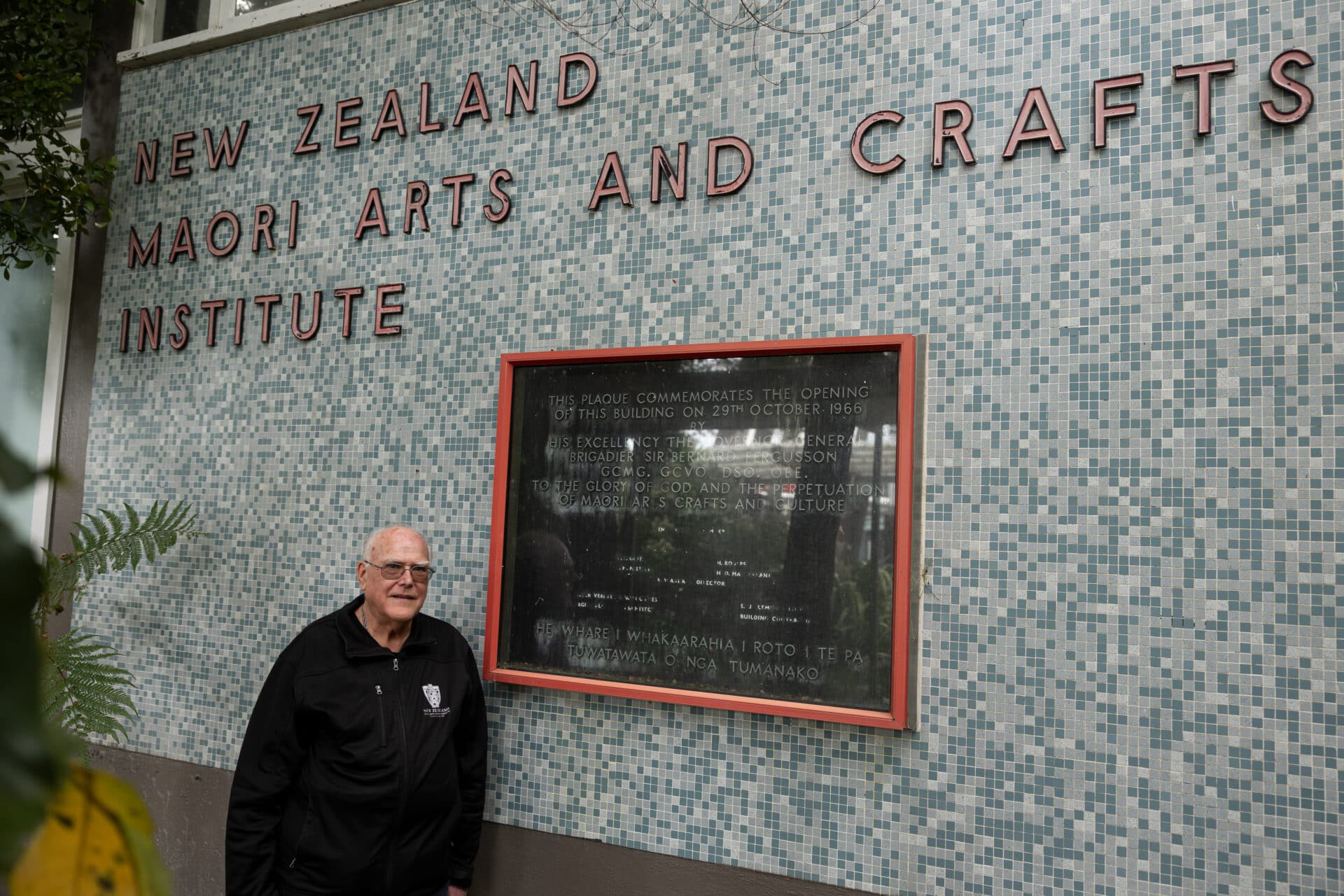Sixty years ago, the 1963 NZ Māori Arts & Crafts Institute Act was passed by Parliament, making it an important time to reflect on its legacy and what lies ahead for the future.
The New Zealand Māori Arts & Crafts Institute (NZMACI) at Te Puia in Rotorua is home to the schools of Te Wānanga Whakairo Rākau (National Wood Carving School), Te Takapū o Rotowhio (National Stone and Bone Carving School) and Te Rito o Rotowhio (the National Weaving School).
New Zealand Māori Arts & Crafts Institute general manager Eraia Kiel says it is a huge achievement for te iwi Māori that NZMACI has delivered on the Act’s responsibilities to protect, preserve and promote Māori culture.
“As we reflect on the last 60 years of cultural perpetuation, I also want to pause and acknowledge that long before this Act, our people, especially the kaiārahi (guides) were instrumental in sharing the knowledge and traditions of Māori culture with tourism manuhiri (visitors) from the late 1800s. This history includes guiding of the Pink and White terraces, till the eruption of Mt Tarawera, then re-establishing here at Whakarewarewa Geothermal Valley.
“The great Māori leader of our time Tā (Sir) Āpirana Ngata and our kaumātua of Te Arawa played a crucial role in fostering cultural understanding, appreciation, and the continued survival of our rich heritage. They were pivotal in the 1926 establishment of Te Ao Mārama, the first carving school at Ōhinemutu and then at Whittaker Road which closed in 1937 with the Great Depression and World War II.”
“I think if they saw what we’ve achieved since the 1963 Act was introduced and since the wānanga was built here at Whakarewarewa, they’d be extremely proud. I believe over this time there’s been some great leaders, tumu (head of schools), pouako (tutors), tauira (students) and graduates who have gone on to do great things with perpetuating culture.
“He rau ringa, e oti ai, the many hands that have contributed,” says Kiel.
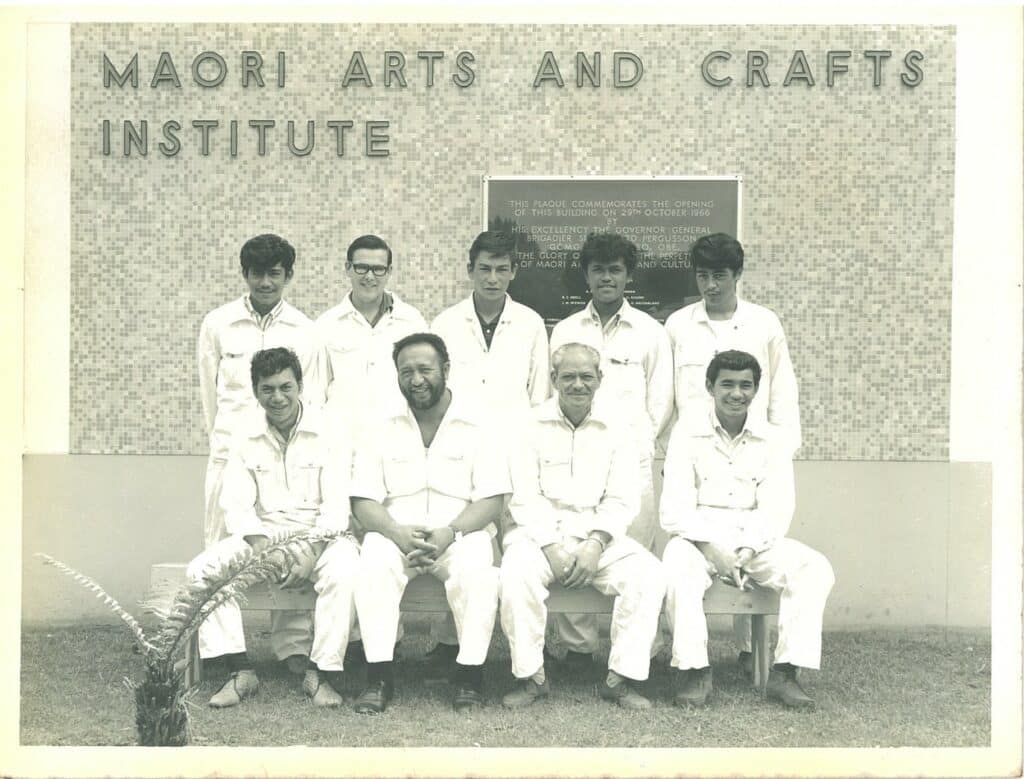
The first intake of tauira (students) at the NZ Māori Arts and Crafts Institute in 1967. Pictured Top L-R: Jimmy Fergus, Clive Fugill, Kapua Riini, Wallace Hetaraka. Bottom L-R: Tutu Honotapu, Tuti Tu Kaokao, Hone Taiapa, James Rickard.
“The New Zealand Māori Arts and Crafts Institute is not just an organisation; it is a living testament to the resilience, creativity, and wisdom of our tūpuna. It serves as a beacon, guiding us forward and reminding us of our responsibility to protect and perpetuate our cultural heritage.
“We have high levels of interest for our intense and very practical hands-on learning programmes where qualifications are conferred by our Masters.”
The Act also refers to tourism and Kiel explains that Te Puia’s visitor experience shares the promotion and perpetuation of Māori culture in a special way, as fourth and fifth generation kaiārahi (guides) take manuhiri on tours of Whakarewarewa Geothermal Valley, Rotowhio Marae, Kiwi Conservation Centre and through NZMACI with a iwi perspective and personal touch. It is a unique model where the commercial tourism supports the cultural development functions and vice versa.
“The fundamental values of manaakitanga, looking after the mana of others, that’s always been our journey of responsibility as mana whenua, to look after anyone that comes into our home.”
Kiel says NZMACI needs to keep its focus into the future, to keep raising the bar and to continue to be a shining beacon for Māori culture and the rest of the world.
Today, the impact of Te Puia | NZMACI is felt far beyond its immediate horizons, empowering indigenous cultures from around the world and strengthening the New Zealand story in important international tourism and trade markets.
“We’re extremely grateful to have people like Clive Fugill, who was one of seven students in the very first intake, helping to guide us into the future,” Kiel explains.
Tohunga Whakairo Rākau Clive Fugill says the kaupapa has always been to teach tauira the traditional arts, so they can take them back to their own iwi and pass on the knowledge.
He reflects on some of the lessons he was taught from the first head of NZMACI from 1967, Tohunga Whakairo Rākau Hone Taiapa, that he now passes on to others.
“Hone would say, the man who makes all the mistakes will learn everything, the man who makes no mistakes will learn nothing.”
Fugill explains that Hone would come and have a look, see what the issue was, and he would always show you how to fix it, he would say “there’s always a way”.
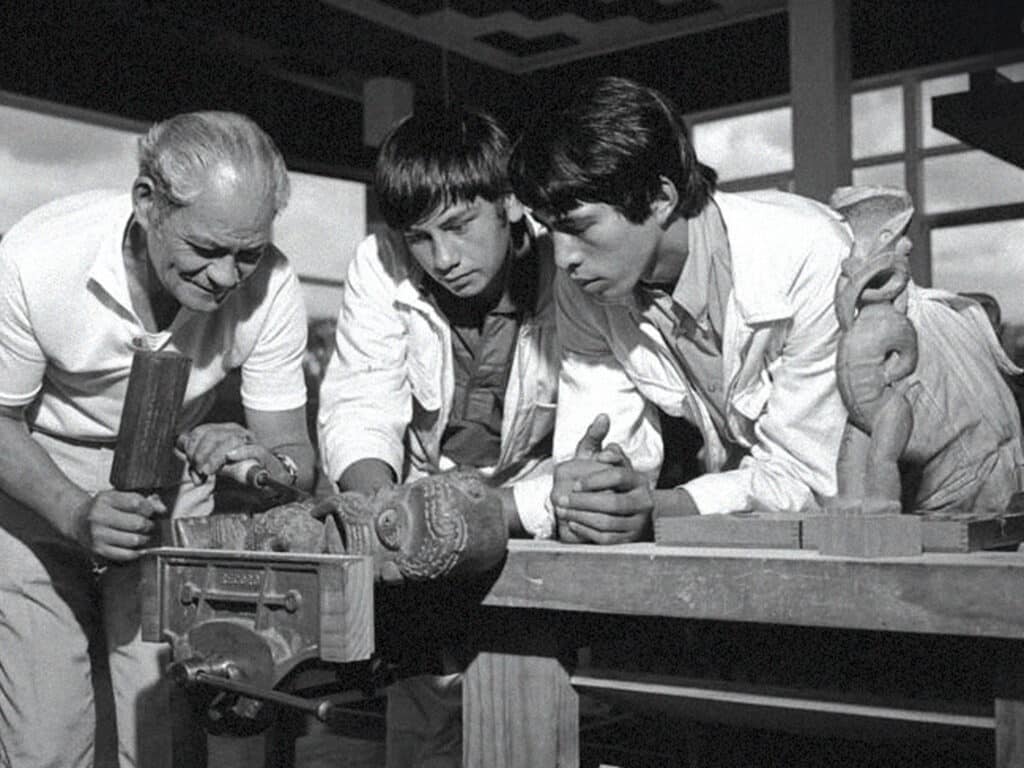
Hone Taiapa and two tauira (students) from the second intake
“I stuck to him like glue to get as much information as possible, it’s now time to pass it on,” says Fugill.
Tohunga Whakairo Rākau Clive Fugill 60 years later in front of the same sign at Te Puia | NZMACI.
“In our first year as students in 1967 we carved tekoteko first using the solid Tōtara from telegraph poles that had been taken down. Three months in, we finished off what was left of the work on Saint Faith’s Church, we also worked on Hangarau meeting house in Tauranga, one of my marae from home. We did carvings for the international hotel at Whakarewarewa, Parawai Marae at Ngongotahā for the Whatumairangi Meeting House, then the DB Hotel carving tukutuku or turapa. I still have records of those frames. We then focused on smaller works, patu, wakahuia, sewing boxes – we had a good grounding in everything.”
Fugill says it is important to also reflect on Te Takapū and Te Rito o te Rotowhio. He shares that Emily Schuster, NZMACI’s first ever head weaver, taught over 5,000 women how to weave. “It’s a huge legacy, it’s helped a lot of people in a lot of ways.
“It’s been an honour and a pleasure to be part of the journey, I’ve had an amazing career, I’ve stuck to the Act and the ideologies of what my master taught me and I pass it on.
“You come here to learn this art to pass it on to the next generation, as Hone Taiapa said.”
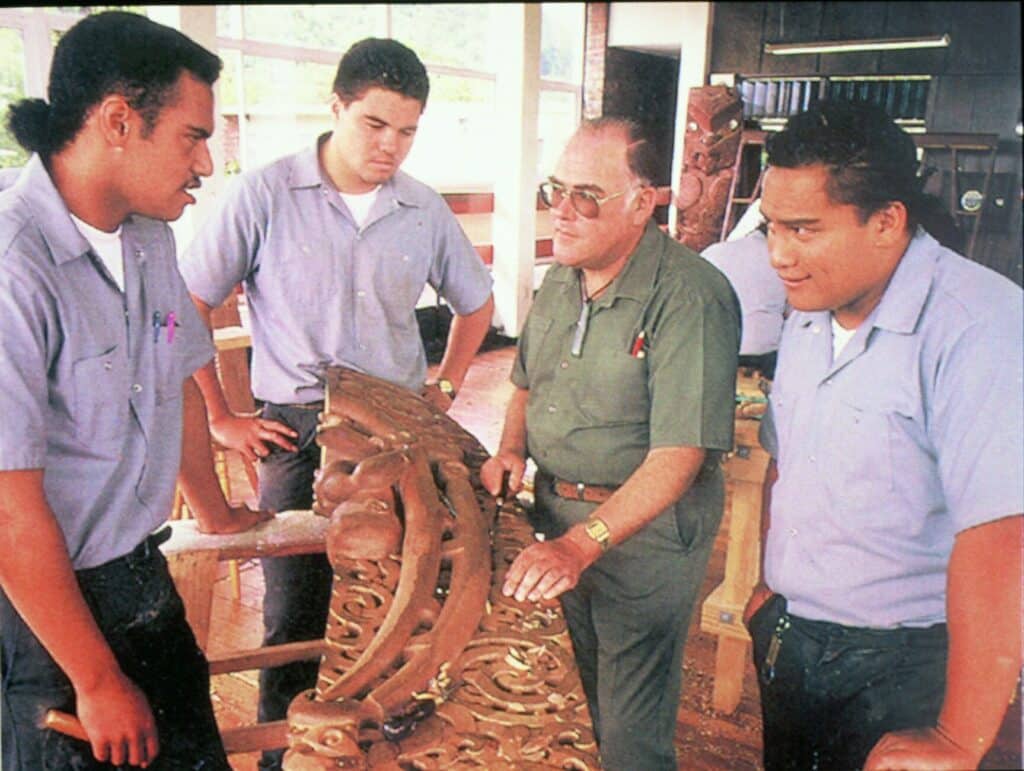
Clive teaching tauira. L-R: Haki Bidois, Robert Rika, Clive Fugill and Haupiri Tawhai
Te Puia | NZMACI celebrated the 60-year milestone with a morning karakia Whakatō Mauri, a mihi by Clive Fugill on the Act and then a haka performed by students at Te Aro-nui-a-Rua meeting house. There will be a range of commemorative events and initiatives over the next 12 months.
Fugill has developed brand marks for the 25, 40 and 50-year milestones. NZMACI is excited to release his 60-year design. It features two hands cupping, holding and embracing the pōito (the pōito is the NZMACI logo). This represents holding and embracing mātauranga Māori knowledge. The cord between the hands represents the whakatauākī: Hei pupuri i te aho o te wānanga, Hei kawe i te kura huna a Rua. Hold fast to the thread of knowledge.
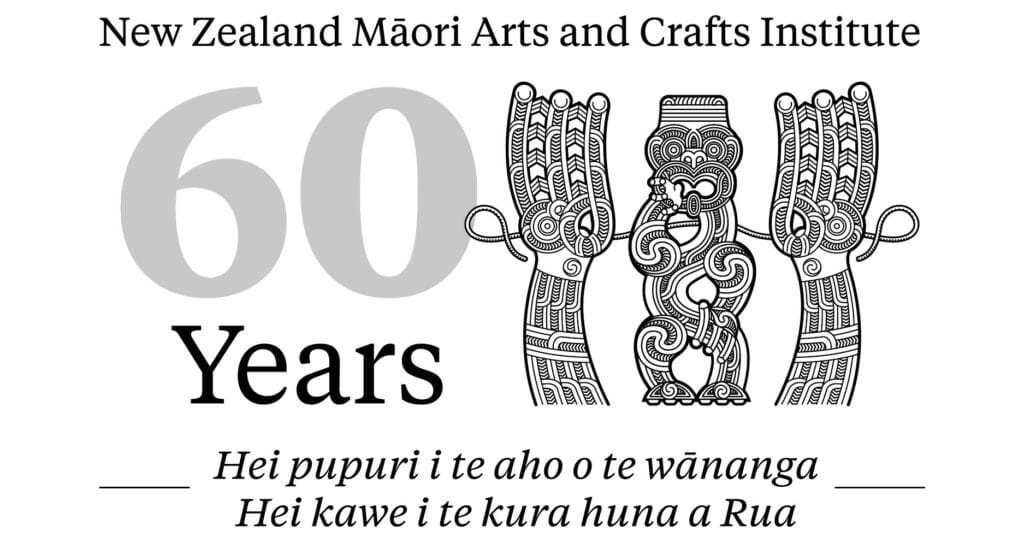
NZMACI 60-year brand mark
While 60 years of history is being recognised, we also acknowledge that Parliament enacted the New Zealand Māori Arts and Crafts Institute Vesting Act in 2020 with mana whenua owners through the Te Puia NZMACI Limited Partnership. The partners are Wāhiao Tūhourangi o Whakarewarewa, the Pukeroa Oruawhata Trust, and Ngāti Hurungaterangi, Ngāti Taeotū, and Ngāti Te Kahu o Ngāti Whakaue. Vesting means that Te Puia | NZMACI is iwi owned.
More information:
The Act:
The New Zealand Māori Arts and Crafts Institute Vesting Act (2020) identifies six functions of the Institute (note these are carried over from the 1963 Act):
- encourage, foster, and promote ahurea and toi Māori (culture and Māori arts) of New Zealand.
- provide training for the iwi of New Zealand, including in whakairo rākau (carving) and raranga (weaving).
- make grants to enable persons to study, train, and gain experience in creating Māori arts and crafts or any other matter approved by the Partnership.
- confer diplomas or certificates on persons who have undertaken training or gained qualifications in Māori arts and crafts or Māori culture generally.
- provide and support demonstrations, exhibitions, and tours of toi Māori and toi whakaari Māori (performing arts) of New Zealand.
- provide for the sustainable development of scenic and tourist attractions in the Rotorua district and elsewhere.
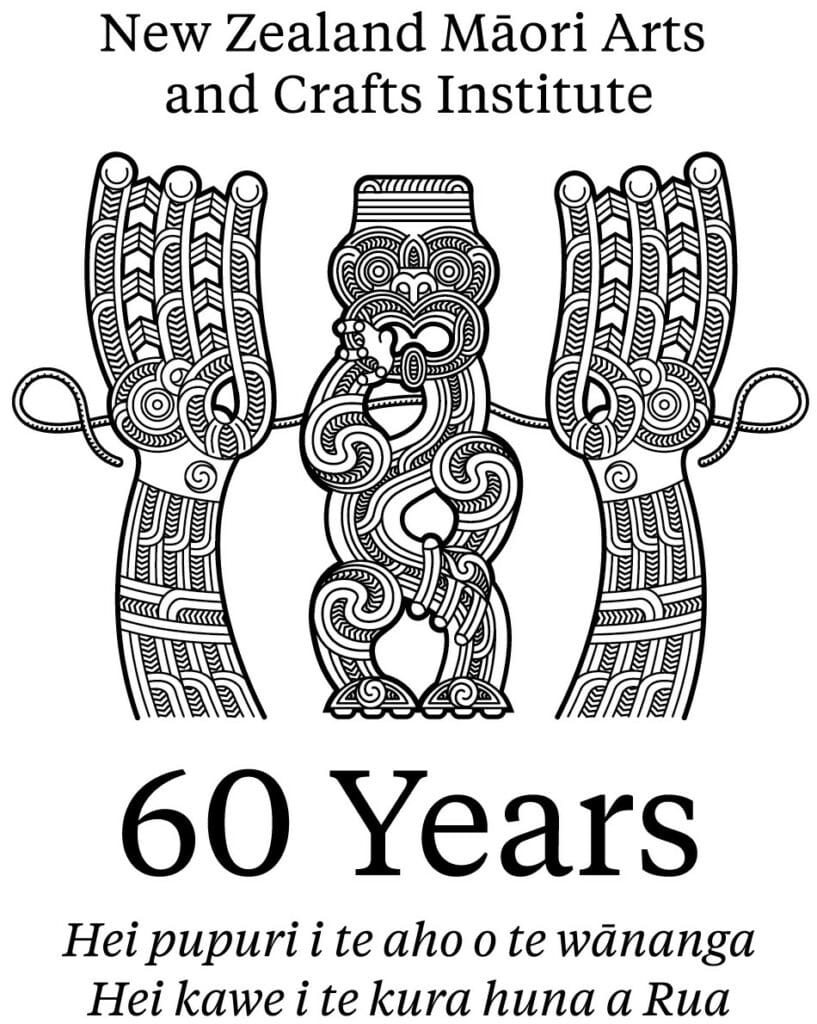
|
60th Anniversary brand mark: Tohunga Whakairo Rākau Clive Fugill has developed brand marks for the 25, 40 and 50-year milestones. NZMACI is excited to release his 60-year design. It features two hands cupping, holding and embracing the poito.
The pōito is the NZMACI brand mark. Pōito were historically carved in various shapes and sizes, stylising the human form. The pōito was used as a floating marker buoy and marine growth would form in the apertures and become phosphorescent at night, identifying the location of tribal fishing grounds. The concept of this design was developed by the Institute’s inaugural Master Carver Hone Te Kauru Taiapa and was implemented by the organisation to symbolise our legislated role to keep Māori cultural heritage afloat.
Therefore, the hands represent holding and embracing mātauranga Māori knowledge. The cord between the hands represents the whakatauki: hai pupuri i te aho o te wānanga – hold fast to the thread of knowledge.
NZMACI History: Since our ancestors first arrived on the shores of Aotearoa New Zealand, our history and kōrero (beliefs and stories) have been carved and woven into patterns, forms and symbols bound together by whakapapa and supported by te reo Māori values and knowledge.
With colonisation and the process of assimilation, this knowledge was threatened by the Tohunga Suppression Act (1907) which inhibited the activities of our tohunga (experts) who were the holders of intensive Māori knowledge.
Renowned Māori leader Tā (Sir) Apirana Ngata recognised that Māori material culture was integral to preserving mātauranga-a-iwi (tribal knowledge and identity). His dream was to establish centres of learning to maintain and preserve traditional practices for future generations. Through Sir Apirana, legislation was passed in Parliament in 1926, bringing his vision to life, with the first carving school, Te Ao Mārama, opening at Ōhinemutu on the shores of Rotorua in 1927, then to a larger premises at Whittaker Road in 1932. However, the school closed in 1937 with the onset of the Great Depression and then World War II.
Twenty-six years later, a renewed focus on the perpetuation of Māori art and craft came to light in the 1960s, combined with Government investment in the growth of Te Whakarewarewa Valley’s tourism interested. This led to a joining of the two in 1963 under the New Zealand Māori Arts and Crafts Institute Act.
While 60 years of history is being recognised, we also acknowledge that Parliament enacted the New Zealand Māori Arts and Crafts Institute Vesting Act in 2020 with mana whenua owners through the Te Puia NZMACI Limited Partnership. The partners are Wāhiao Tūhourangi o Whakarewarewa, the Pukeroa Oruawhata Trust, and Ngāti Hurungaterangi, Ngāti Taeotū, and Ngāti Te Kahu o Ngāti Whakaue. Vesting means that Te Puia | NZMACI is iwi owned. The functions of the 1963 Act have been brought through to the 2020 Act.
